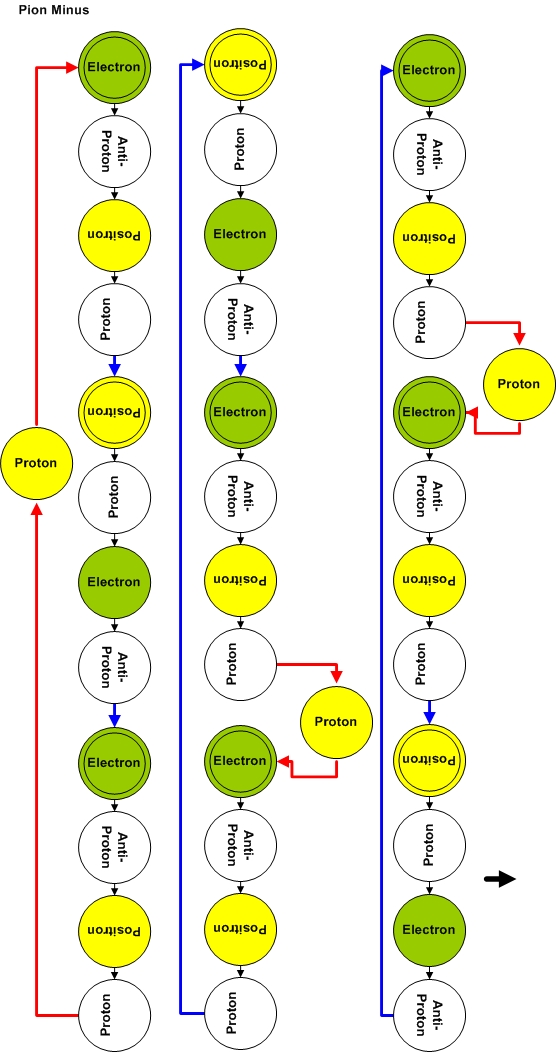How to represent this coherence in 4D
41 views
Skip to first unread message
Marco Pereira
Dec 24, 2021, 7:00:14 PM12/24/21
to QuTiP: Quantum Toolbox in Python
This is a representation of a coherence between two states: electron and proton state.

In fact, there are two coherence, one representing the electron and the other representing the positron.
Each state has to be represented by a mass and a shape. The lettering indicates the orientation of the state with respect to our 3D hypersurface. That is a physical representation of spin (rotation around an axis perpendicular to the 4th dimension).
I need to create the classes associated with the two states and the corresponding evolution operator that moves the class from one state to the other. Later, I will need to add another operator to act upon the classes to execute a rotation within the 3D hypersurface.
I suspect this is all very easy to do using QuTip but since I just saw that package I would love to have some help.
Thanks,
Marco Pereira
Simon Cross
Dec 27, 2021, 5:42:14 AM12/27/21
to qu...@googlegroups.com
Hi Marco,
I don't know what your diagram represents exactly, but perhaps another explanation of what system you are trying to model would allow me or someone else on the list to understand enough to make some concrete suggestions.
Regards,
Simon
j794...@uwaterloo.ca
Jan 20, 2022, 1:28:19 AM1/20/22
to QuTiP: Quantum Toolbox in Python
Hi,
I suppose your problem lies more in the physics but not coding.
You may think more to write down an appropriate set of basis to represent your electron-proton system. You can use pair of numbers to represent a state: |n, m>, which can be constructed by tensordot in qutip. Futhermore, you need to write the right Hamiltonian to do time-evolution.
Marco Pereira
Jan 20, 2022, 10:51:49 AM1/20/22
to QuTiP: Quantum Toolbox in Python

Dear Simon,
This is a representation of a pion minus as a coherence of stationary states of space deformation.
It is a trimer and rotates 120 degrees at each cycle.
The axis of rotation is perpendicular to our 3D space. Red and blue lines are transmutation chords and are associated with rotations without our 3D space (as opposed to spin which is represented by the rotation of the lettering).
So, my initial goal would be to represent this coherence in QuTip. Notice that one can ascribe a radius for this rotation.
So, it is not that I don't know Physics. The issue is that I am creating a distinct representation of Matter.
You might disagree with it, and I will be happy to learn from you once you understand what I am trying to do.
The Lagrangian doesn't need to be written since I can minimize it directly from geometry and the Quantum Lagrangian Principle, the same principle I used to derive macroscopic Natural Laws.
My initial explanation involved just proton and electron (which are monomers). A pion is more complex but it seems to be necessary for my explanation.
Let me know if this is clearer.
What you told me to do seems to be good for representing states but not coherence. Am I wrong?
Even that, I would welcome a short coding example (I never user QuTip)
Thank you in advance,
Marco
Simon Cross
Jan 20, 2022, 12:27:59 PM1/20/22
to qu...@googlegroups.com
Hi Marco,
Your graphical representation is not one I'm familiar with, so if you'd like help you'll need to provide a reference explaining it. If it's your own representation, that's great, but it still needs to be explained (if it is your own, please write an explanation somewhere and post a link -- no not attempt to explain it all directly here :).
You can find the QuTiP documentation at https://qutip.org/docs/latest/index.html (it contains many guides and examples and reference documentation) and a multitude of tutorial at https://qutip.org/tutorials.html.
Hope this is helpful!
Regards,
Simon
Marco Pereira
Jan 20, 2022, 7:14:25 PM1/20/22
to qu...@googlegroups.com
Simon,
Thank you for asking. It is never wise to provide the full explanation upfront without knowing if anyone would make an effort or be interested enough to learn it.
Here is the first two-page explanation about the Fundamental Dilator.
Here is what I did with it in Cosmology:
This is the first article of a series. That said, it seems for an editor to have the courage to even send my work to peer-review, never mind publish it.
I also would like to see the QuTip implementation of the Dirac equation. Do you know anyone who had done it?
Please, feel free to ask questions.
Thanks,
Marco Pereira
--
You received this message because you are subscribed to a topic in the Google Groups "QuTiP: Quantum Toolbox in Python" group.
To unsubscribe from this topic, visit https://groups.google.com/d/topic/qutip/mEbDSlMLnsg/unsubscribe.
To unsubscribe from this group and all its topics, send an email to qutip+un...@googlegroups.com.
To view this discussion on the web visit https://groups.google.com/d/msgid/qutip/CAD5NRCEQWNQuqv%3D0T6QYORe0%2BjFoxhTRAr90Y7%2BK7OV3GRCq3g%40mail.gmail.com.
Marco Pereira
Jan 20, 2022, 7:15:57 PM1/20/22
to qu...@googlegroups.com
Simon,
Now I noticed that you asked me to post a link. I am new to discord and googlegroups. I am not sure where to post this link.
Marco
Reply all
Reply to author
Forward
0 new messages
